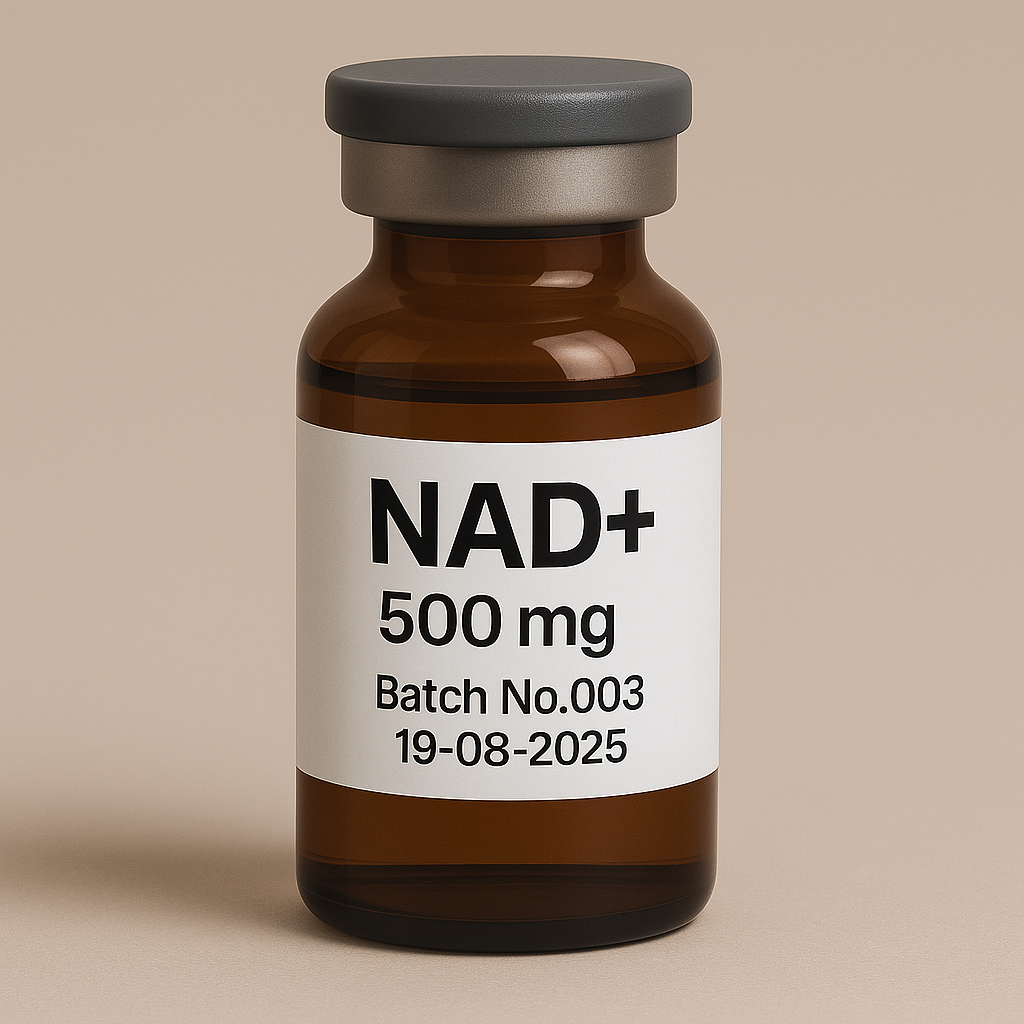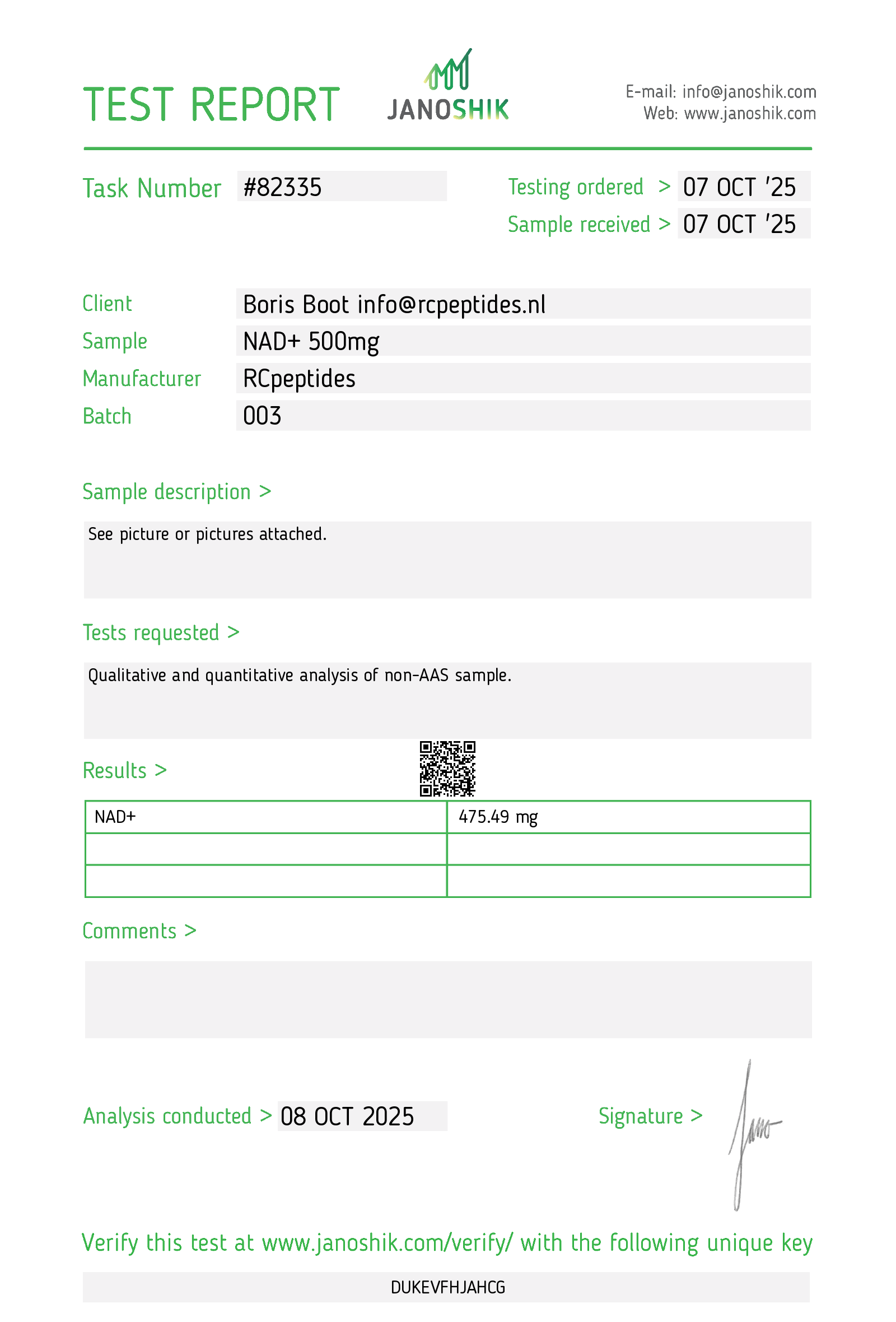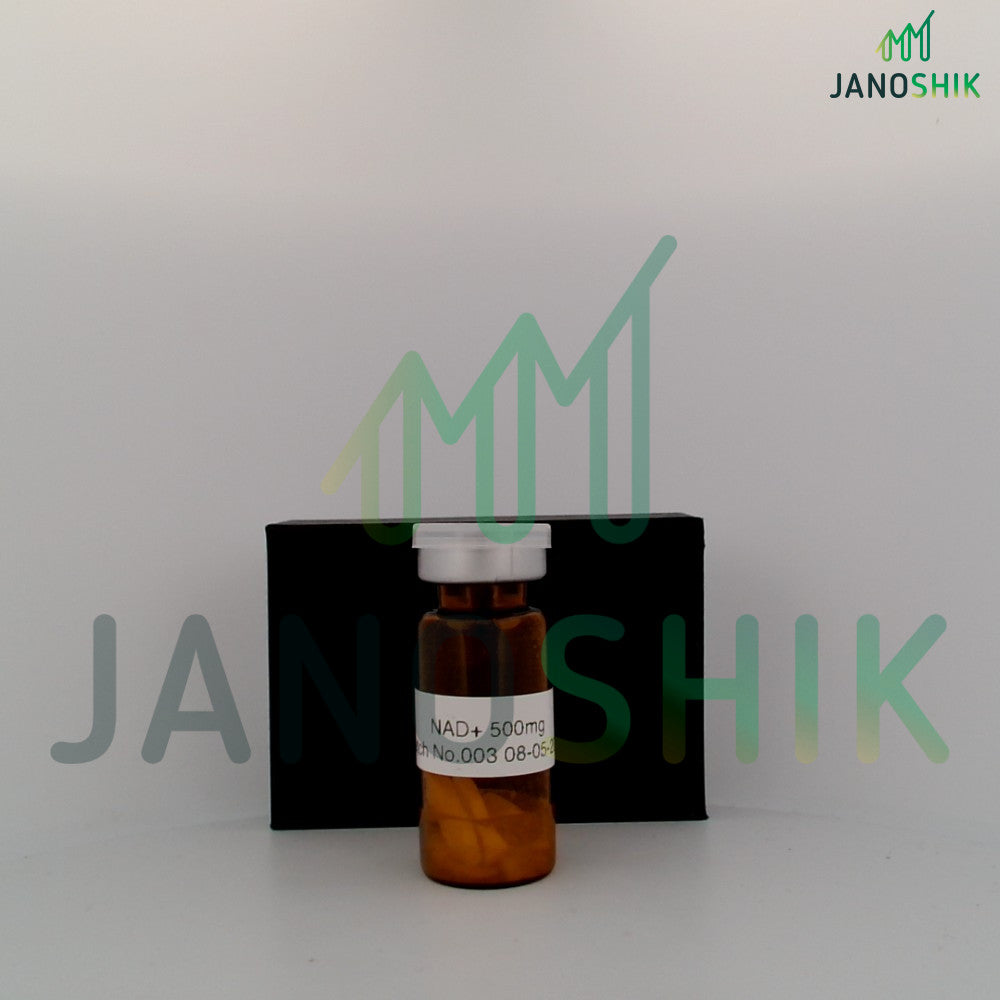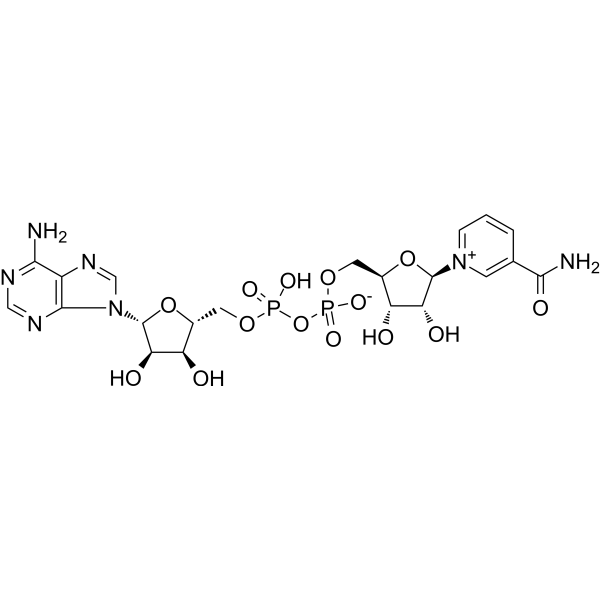
NAD+ 500mg vial
Pickup currently not available
NOT FOR HUMAN CONSUMPTION
Nicotinamide adenine dinucleotide (NAD⁺) is a universal redox cofactor and enzyme substrate central to energy metabolism (NAD⁺/NADH) and cell signalling. As a co-substrate, NAD⁺ fuels sirtuins (SIRT1–7), PARPs, CD38/CD157, and SARM1, thereby governing mitochondrial biogenesis, DNA repair, circadian timing, immune tone, and axon integrity. Tissue NAD⁺ falls with aging and cardiometabolic stress due to increased consumption (PARPs/CD38) and impaired salvage. Augmentation strategies include dietary precursors (nicotinamide riboside, NR; nicotinamide mononucleotide, NMN; niacin/NA; nicotinamide/NAM; tryptophan→kynurenine pathway), enzyme targeting (boost NAMPT, inhibit CD38/PARP), and parenteral NAD⁺ (investigational). No NAD⁺-raising therapy is FDA/EMA-approved for disease modification; NR is widely sold as a supplement; NMN has variable regulatory status by country; IV NAD⁺ is not an approved drug.
Additional Benefits of NAD⁺ Repletion Now Under Investigation
| Benefit | Key take-aways |
|---|---|
| 1 Mitochondrial function & ATP | NAD⁺ restoration increases SIRT1/PGC-1α activity, OXPHOS proteins, and mitochondrial biogenesis, improving skeletal-muscle oxidative capacity. <br/><em>Cell Metabolism; Nature Communications</em> |
| 2 Insulin sensitivity & metabolic flexibility | In overweight adults, NMN improved muscle insulin sensitivity without weight loss; NR shows modest glycaemic/lipid benefits in some cohorts. <br/><em>Science; Diabetes</em> |
| 3 Vascular aging | NR increased whole-blood NAD⁺ and reduced aortic stiffness/clinic BP in mid-life adults with elevated cardiovascular risk. <br/><em>Nature Communications; Hypertension</em> |
| 4 Liver fat & NAFLD | Preclinical and pilot human studies suggest lower hepatic steatosis, ALT/AST improvements, and reduced lipogenesis with NAD⁺ precursors. <br/><em>Hepatology; Liver International</em> |
| 5 Neuroprotection & cognition | NAD⁺ supports axonal survival (SARM1 restraint), synaptic plasticity, and mitochondrial quality; small trials report signals in sleep/cognition and neurodegenerative contexts. <br/><em>Neuron; Journal of Alzheimer’s Disease</em> |
| 6 Exercise performance & recovery | Increased VO₂peak and fatty-acid oxidation markers with NR/NMN in some studies; others are neutral—benefits may depend on baseline fitness and dose. <br/><em>Medicine & Science in Sports & Exercise; FASEB Journal</em> |
| 7 Kidney & cardiac stress | NAD⁺ repletion mitigates AKI/CKD progression and post-ischemic cardiac dysfunction in models via DNA-repair and mitochondrial pathways. <br/><em>Nature Medicine; Circulation Research</em> |
| 8 Immune resilience & inflammation | By modulating CD38/PARP and SIRT networks, NAD⁺ can reduce inflammaging markers and enhance antiviral responses; human data are early. <br/><em>Immunity; Geroscience</em> |
| 9 Skin & barrier biology | Topical/oral precursors improve barrier lipids, collagen transcripts, and UV-repair capacity; cosmetic endpoints show benefit. <br/><em>Dermatology; Redox Biology</em> |
2. Molecular Mechanism of Action
2.1 Enzyme Pharmacodynamics
-
Sirtuins (SIRT1–7): NAD⁺-dependent deacylases → PGC-1α activation, mitochondrial biogenesis, NF-κB dampening, improved insulin signalling.
-
PARPs (PARP1/2): DNA-damage sensors; high activity consumes NAD⁺ and limits ATP; controlled activity supports genome stability.
-
CD38/CD157: Ecto-enzymes that hydrolyze NAD⁺ to cyclic/linear ADPR; upregulated with age/inflammation.
-
SARM1: Pro-degenerative axonal NADase; inhibition/offset by higher NMNAT and NAD⁺ supports axon survival.
2.2 Upstream/Downstream Biology
| Module | Functional outcome | Notes |
|---|---|---|
| Salvage (NAM→NMN→NAD⁺; NAMPT, NMNATs) | Maintains cytosolic/mitochondrial NAD⁺ pools | NRK converts NR→NMN |
| De novo (Trp→Kyn→QA) | Backup NAD⁺ supply; inflammation diverts flux | Kynurenines immunoactive |
| Redox (NAD⁺/NADH) | Glycolysis/TCA/ETC flux | Couples to ROS handling |
| Circadian (CLOCK/BMAL1–SIRT1) | Aligns metabolism with day/night | NAD⁺ oscillates diurnally |
3. Pharmacokinetics (augmentation strategies)
-
Oral NR: Rapid absorption; increases blood/tissue NAD⁺ within hours; half-life minutes; excreted as MeNAM → 2PY/4PY in urine.
-
Oral NMN: Converted to NAD⁺ via NRK/NMNAT; a putative SLC12A8 transporter is described in mice; human transport remains debated; raises blood NAD⁺ within hours.
-
Niacin (NA) / Nicotinamide (NAM): Classical precursors; NA causes flush, improves lipids at pharmacologic doses; NAM raises NAD⁺ but at high doses increases MeNAM/2PY/4PY (methylation sink).
-
IV NAD⁺ (investigational): Transient plasma rise with downstream NAM/MeNAM; intracellular access largely via extracellular breakdown→precursors.
-
Clearance: Predominantly urinary MeNAM/2PY/4PY; high doses tax methyl donors (SAM).
4. Pre-clinical and Translational Evidence
4.1 Human trials (selected themes)
-
NR: In mid-life/older adults, raises NAD⁺ and reduces aortic stiffness/BP; variable effects on insulin sensitivity and lipids; generally well tolerated.
-
NMN: In overweight/prediabetic adults, improved muscle insulin sensitivity and skeletal-muscle NAD⁺ signalling over 10–12 weeks.
-
Niacin/NAM: Robust lipid effects for niacin but limited by flush, insulin resistance, and gout risk; high-dose NAM limited by GI/hepatic tolerability.
-
IV NAD⁺: Used in clinics for wellness/withdrawal claims; rigorous RCT data are lacking.
Evidence quality note: Strong mechanistic and animal data; human RCTs show reliable biochemical NAD⁺ rises and signal-level clinical effects (vascular/insulin sensitivity) but mixed results for performance, weight, and hard outcomes. Larger, longer trials are in progress.
5. Emerging Clinical Interests
| Field | Rationale | Current status |
|---|---|---|
| Geroscience/sarcopenia | Mitochondrial + inflammatory axis | Phase 2–style signals |
| Cardiometabolic risk | Vascular aging, NAFLD, insulin resistance | Mixed RCTs; more powered studies needed |
| Neurodegeneration | Axon survival (SARM1), mitochondrial support | Early human; strong preclinical |
| Kidney injury/CKD | DNA-repair & metabolic rescue | Translational |
| Oncology-adjacent | Support normal tissue; complex tumor biology | Preclinical; caution in active cancer |
| Dermatology/cosmeceuticals | Barrier/collagen/UV repair | Small trials; cosmetics |
| Critical illness/sepsis | PARP overuse & NAD⁺ collapse | Pilot investigations |
6. Safety and Tolerability
-
NR/NMN (oral, usual trial doses): Generally well tolerated (flushing uncommon). GI upset, headache, fatigue, pruritus occur in a minority.
-
Niacin (NA): Flushing, itching, hypotension, ↑ uric acid/gout, ↑ glucose/insulin resistance, hepatotoxicity risk (especially sustained-release forms).
-
Nicotinamide (NAM): Better tolerated than niacin; hepatotoxicity at high doses (≥3 g/day), nausea, headache; increases MeNAM/2PY/4PY (methyl-sink)—consider folate/B₁₂/betaine sufficiency.
-
IV NAD⁺: Infusion-rate related nausea, chest/abdominal tightness, lightheadedness; sterile-prep and monitoring required; no disease indication approved.
-
Biologic cautions:
-
Active malignancy: Some tumors are NAMPT/NAD⁺-addicted; indiscriminate NAD⁺ boosting could be counterproductive—oncology oversight advised.
-
Drug interactions: Theoretical with PARP inhibitors, chemotherapy (DNA-repair), and immunotherapies; monitor in trials.
-
Methylation burden: High NAM/NR intake increases methylated metabolites; watch homocysteine and methyl-donor status.
-
Comparative safety matrix
| Feature | NR | NMN | Niacin (NA) | Nicotinamide (NAM) | IV NAD⁺ |
|---|---|---|---|---|---|
| Human NAD⁺ rise | Yes (robust) | Yes (robust) | Yes | Yes | Transient/systemic |
| Key pros | Good GI tolerability; vascular signals | Insulin-sensitivity signal; good GI | Lipid-lowering (HDL↑ TG↓) | No flush; inexpensive | Rapid levels; bypass GI |
| Key cons | Possible LDL/TG drift in some; cost | Regulatory variability; cost | Flush, glucose↑, uric acid↑, hepatotoxic (SR) | Hepatotoxicity at high dose; methyl sink | Rate-limited AEs; no approved indication |
| Evidence level | Multiple small–moderate RCTs | Early RCTs | Extensive (lipids) | Moderate | Sparse/heterogeneous |
7. Regulatory Landscape
-
Approved drugs: None for “NAD⁺ repletion” as a disease therapy.
-
Dietary supplements (US/EU varies): NR broadly marketed; NMN status varies/contested; niacin/NAM are established vitamins.
-
Parenteral NAD⁺: Not FDA-approved; clinic use is off-label/wellness without disease claims.
-
Quality: Use GMP sources; third-party testing helps reduce adulteration and label-claim gaps.
8. Future Directions
-
Phenotype-targeted trials: Visceral-obese NAFLD, pre-diabetes, hypertensive mid-life adults, CKD, and early neurodegeneration with biomarker-anchored endpoints.
-
Mechanism-guided combos: NR/NMN + exercise, caloric periodization, SGLT2/GLP-1 co-therapy; CD38 inhibition to preserve NAD⁺; methyl-donor support when using high NAM/NR.
-
Outcome end-points: Hard outcomes (fractures, MACE, CKD progression), not just NAD⁺ levels.
-
Compartmental NADomics: Distinguish cytosolic vs mitochondrial pools, tissue targeting, and clock-time dosing to align with circadian NAD⁺ oscillations.
-
Safety science: Long-term oncology surveillance, hepatobiliary panels, homocysteine/methylation monitoring at higher doses, and standardized IV NAD⁺ protocols.
Selected References
-
Trammell S.A.J. et al. Human NR pharmacokinetics and NAD⁺ metabolome. Cell Metabolism.
-
Martens C.R. et al. NR lowers aortic stiffness and blood pressure in older adults. Nature Communications.
-
Yoshino J. et al. NMN improves insulin sensitivity in prediabetic women. Science.
-
Mills K.F. et al. NAD⁺ repletion improves mitochondrial function and lifespan in models. Cell Metabolism.
-
Camacho-Pereira J. et al. CD38 drives age-related NAD⁺ decline; inhibition restores function. Nature Medicine.
-
Lautrup S. et al. NAD⁺ in brain aging and disease. Nature Reviews Neurology.
-
Rajman L., Chwalek K., Sinclair D. Therapeutic potential of NAD⁺ precursors. Cell Metabolism.
-
Canto C., Auwerx J. NAD⁺ and sirtuins in metabolic control. Cold Spring Harbor Perspectives in Medicine.
-
Katsyuba E., Auwerx J. NAD⁺ homeostasis: from tryptophan to therapy. Nature Metabolism




